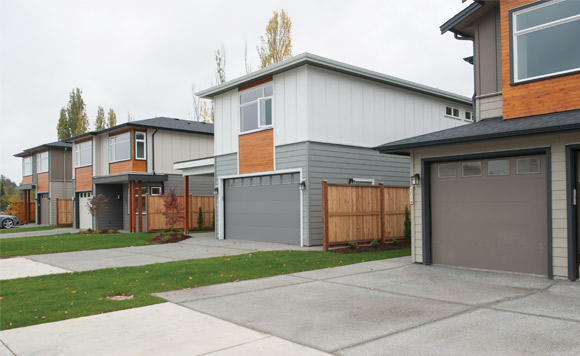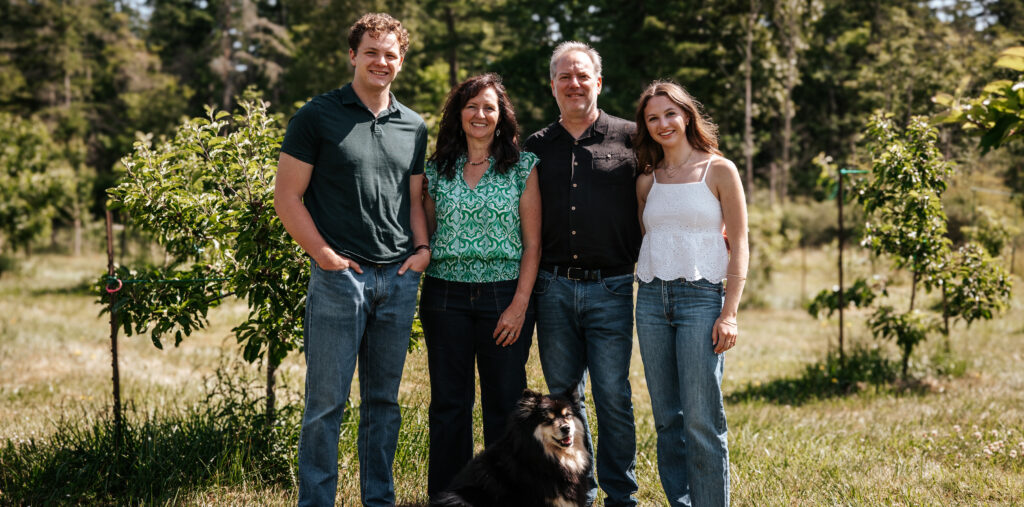by Janice Henshaw –
“To avoid criticism, say nothing, do nothing, be nothing.” So said Elbert Hubbard in 1898. In thinking of those words, do you sometimes wonder who in our community is willing to face criticism and rise to the challenge of planning for future growth on the Peninsula? And what their plans are?
Evan Peterson, the owner of Barefoot Planning, a Victoria-based planning and urban design consultancy, believes that our communities are facing a number of extraordinary challenges, including an “unprecedented housing crunch and the small matter of a changing climate.” In response to these challenges, Evan says: “We need to change our predominant development paradigm and respond with innovation at multiple scales – from greener buildings to properly functioning watersheds.”
“At the neighbourhood level, innovation is not about patching over or dressing up our dysfunctional post-war development patterns,” says Evan, “but is instead about directly addressing the causes of these unsustainable, unhealthy and inequitable built forms. Put simply, it means a transition from (so many) low-density, car-oriented, single-use areas (e.g., suburbs, strip malls) to higher density, walkable, mixed-use neighbourhoods.”
This is not a new idea and Evan says that, as a planner: “It feels tired and clichéd. Yet, we have so few local examples – primarily due to outdated development regulations, a culture resistant to change (regardless of its merits), and a social climate that tends to be problem – rather than solutions – oriented. (When you read ‘higher density,’ did you cringe a little?) So, what we often create instead is more of the same … or a watered-down version of the real thing (e.g., compact yet auto-centric development).”
Evan believes that neighbourhoods should transition from an emphasis on a lot of private outdoor space and single-family homes to neighbourhoods that have a series of common spaces in which to build community: spaces that allow for interaction between neighbours, create areas for kids to play, and set aside room for gardens and other amenities. Instead of tracts of detached family homes, he envisions a stacked mix of unit sizes and configurations, accommodating residents throughout their lifespan. “As you begin to replicate this basic concept across a neighbourhood,” Evan says, “you suddenly have the population density to viably support shops, services, and transit integrated within walking distance of people’s homes.” In addition to environmental and health benefits, this allows people to remain in their communities longer as they age.
That sounds good as far as it goes; however, Evan says the innovative part comes in the effective layering of built, social and ecological infrastructure. “The built infrastructure houses and moves us (i.e., homes and streets/paths, etc.). The social infrastructure connects us and enhances our well-being (i.e., playgrounds, recreation centres, childcare, seniors care, etc.). The ecological infrastructure maintains proper ecological functioning and a healthy living environment (e.g. urban forests, wetlands, rain gardens, bioswales, etc.).” Evan believes we cannot “simply densify without the design consideration to creating livable spaces and the ecological consideration of maintaining or restoring functioning ecosystems.”
Some of the principles Evan discussed can already be found being put to work in Sidney and North Saanich. Town of Sidney Municipal Planner Corey Newcomb explains that Sidney is focused on developing the town as a truly walkable community for all residents. “We believe this will help to improve the quality of new housing and also the economic and social health of residents and the local environment.”
Sidney planners have also worked with developers to build “live/work” units in the downtown, says Corey. “This allows ground floor commercial units to be used for residential purposes as well. Sidney is also promoting residential units for families downtown by requiring 10% of any new units in multifamily buildings to be three-bedroom units, and the units must be on the lower floors so they don’t end up as high-end penthouse units. Town Council has recently established an affordable housing fund to help facilitate new affordable units in Sidney.
Sidney’s Official Community Plan focuses on putting density close to the downtown, where most of the amenities are located. As part of development in and around the downtown, Corey says Sidney is pursuing public and “active transportation” options like improved sidewalks and cycling facilities. A recently adopted bylaw requires bicycle parking in multi-family buildings and provides additional on-street bike parking with new development. “Overall, we are working toward building a greener, more sustainable lifestyle option in Sidney, of which housing and transportation are two big factors – and we’re trying our best to make this lifestyle available for everyone.”
In addition, Sidney Council is trying to expand this successful model of green urban living. “Currently in the works as part of the West Side Local Area Plan (for the industrial area west of Highway 17) is an idea to create an innovative mixed-use village that could potentially include a large component of affordable housing and much improved active transportation options.”
In North Saanich, Mayor Alice Finall says that since its incorporation over 50 years ago, residents have supported Official Community Plans that emphasized slow growth and sustainable land use patterns. The focus has been on “protecting, maintaining and enhancing rural, agricultural and marine resources.”
As a result, Mayor Finall says, “North Saanich is one of the healthiest, most livable and most beautiful communities in the region and perhaps on the Island.” There is an extensive trail network throughout the municipality, a large provincial park, several CRD parks, numerous municipal parks, and several public beach access points. All of these enhancements “substantially contribute to the health of our residents as well as residents from other regions that access them.”
The zoning in North Saanich provides considerable opportunity for market housing, explains Mayor Finall, but “current housing needs are definitely in the non-market, subsidized range.” She says that Council is moving forward with an Affordable Housing policy to address this need now and into the future. She notes that Council has already adopted measures to support non-market or below-market housing, including allowing secondary suites in most of the municipality, and carriage houses on properties that are larger than one acre. “These efforts increase housing affordability options without undue destruction of the livability of the community.”
Thank you, Evan, Corey, and Mayor Finall for sharing your ideas and giving so generously of your time. It’s clear that you don’t believe in following Elbert Hubbard’s wry non-advice.
(Editor’s Note: Unfortunately, we did not receive input from Central Saanich as CAO Patrick Robbins said he was unable to participate at this time due to competing priorities and capacity.)




